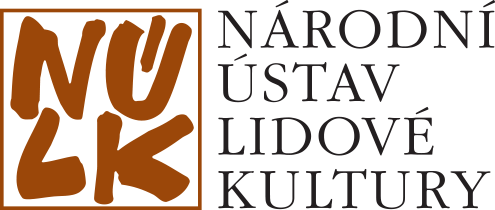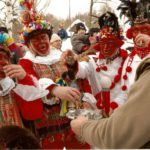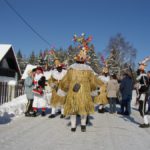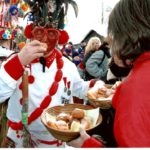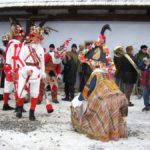UNESCO list: 2010, National list: 2009
The village door-to-door processions and the masks associated with them in the Hlinecko area are part of a tradition that has survived in the active subconscious mind and that has been practised to date. The village Shrovetide processions in the Hlinecko area express traditional interests of the originally rural community: rich harvest, prosperity of livestock and farmyard, and health of family. They are even associated with the magic ensurance of fertility. The knowledge about the original functions of Shrovetide processions and masks in the villages of the Hlinecko area has survived to date even though their social and entertainment functions predominate at the first glance now.
Reprezentativní seznam - Nominační dokumentace "Vesnické masopustní obchůzky a masky na Hlinecku" verze CZ ENG version
Národní seznam - Nominační dokumentace "Vesnické masopustní obchůzky a masky na Hlinecku"

Descriptions of this element have survived from the mid-19th century. We can find them for example in chronicles of the villages of Holetín, Vortová, and Ždírec stored at the State District Archives in Chrudim. Karel Václav Adámek in his monograph Lid na Hlinecku [The People in the Hlinecko Area] (Praha, 1900) described the village Shrovetide door-to-door processions, masks, hospitality and rhymes of masks, as he captured them at the end of the 19th century. Based on these sources we can find out that the course and the form of the village Shrovetide door-to-door processions in the Hlinecko area have changed only slightly to date. The changes reflected by the village Shrovetide door-to-door processions in the Hlinecko area, as compared with the 19th century, are as follows: the number of locations in which the Shrovetide door-to-door processions take place has been reduced since the 1960s. The date of the event is another visible change – since the end of the 1960s, the processions have been held on the nearest Saturday or Sunday before Shrovetide Tuesday. Some of materials used to make Shrovetide masks have been replaced by other ones (some natural materials have been replaced by the artificial ones), the huts and caps worn by several masks are “decorated with pictures of scantily dressed women”; some props used by the masks have changed. The number of masks in the group of the “Black Mask” has increased. Until the early 1950s, there was only one mask in the group, now there are three or four masks.
The procession itself is preceded by preparations: it is necessary to ensure music, refreshment, and in particular to make masks. In the morning, currently on the last Saturday or Sunday of Shrovetide, the masks gather in a place and in a procession, they go to the mayor to ask him to permit the door-to-door procession. After having been given the mayor´s consent, the masks go from door to door, they dance in front of the inhabitants and contact the onlookers with words and gestures. They are given usual refreshment outside each house (doughnuts, open sandwiches, alcoholic drinks) and a financial fee. Its amount depends on the habits in a particular community. The procession is accompanied by a brass music band with a clarinet, a flugelhorn, a trombone and percussion instruments. The procession is closed with the ritual called “Killing of the Mare” which takes place in a place known in advance. During this ritual, the mare is condemned for its alleged sins. The judgment and the mare´s testament are read by one of the masked men. In a humorous form, he responds to different events in the village and society (increasing prices, unemployment). At the end of the reading, the mare kneels down, the masked man removes its cap, which means that the mare is symbolically executed. It falls to the ground and does not move. Other masks make a round around it, lay their caps on the ground and move in the circle, accompanied by sad music. After the end of the song, the masked man gives the mare some alcohol. The mare comes to life again, springing up. Then a funny dance of the masks with the onlookers follows. This act represents the essence of the Shrovetide door-to-door processions: the symbol of death (winter) and new life, resurrection (spring). The follow-up evening dance party bids farewell to the cheerful Shrovetide period.
